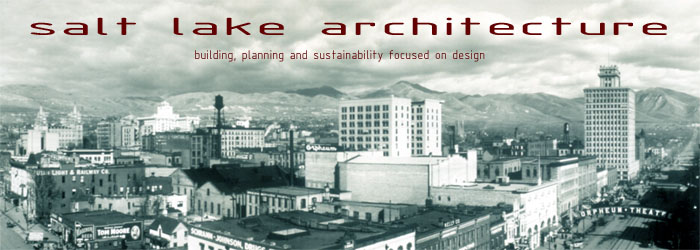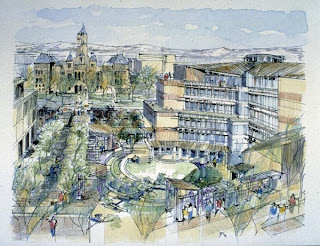
Antelope Island is the largest island in the Great Salt Lake, and probably the most beautiful. Its magnificent scenery provides a mix of grassland and desert. The Visitors Center is located at Ladyfinger Point on the island’s north end and acts as an educational and resource center for the Great Salt Lake ecosystem. Completed in 1995 by
EDA Architects, the Visitors Center is a good example of the quality work this local firm in downtown SLC is capable of.
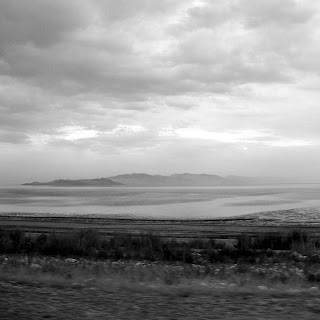 View of the Salt Lake and surrounding mountains
View of the Salt Lake and surrounding mountains Buffalo of Antelope Island
Buffalo of Antelope IslandIn mid-1993, the Utah Division of Parks and Recreation considered developing the island with multiple visitors centers, lodges, restaurants, a small strip mall, historical markers, and hiking trails. The goal was to seek a balance of meeting visitor needs with protection of the island environment. Fortunately the commercial development portion never saw the light of day. "The power of Antelope Island is in its stark beauty," said author Terry Tempest Williams, whose book
Refuge brought international attention to the Great Salt Lake. "The notion of a strip mall residing on the flanks of this wild place strikes me as the worst possible intrusion. If a museum or educational center or a restaurant or even a strip mall are in the minds of our state park managers, let them stake their claim somewhere in Davis County. The question I have for the state is, 'When will we learn to restrain ourselves?' We need silence more than we need entertainment."
 Natural wildflowers of Antelope Island
Natural wildflowers of Antelope Island Google Maps aerial image
Google Maps aerial image"Mitch Larsson, longtime park manager at the island, said limited commercial development of the park would entice visitors to stay longer. That means more money for local economies.
Mr. Larsson told a group of teachers taking a class on the island last weekend that a small strip mall and restaurant were being considered. On Monday, he said he envisions a 'Mount Rushmore-type visitor center.' This likely would include an information center, lookout observation deck, restaurant and gift shop.
The state also would consider building a motel or lodge near the new marina, Terry Green, chief planner for the parks agency said. Any commercial development would be based on public demand and the Division of Parks and Recreation's own environmental studies."
(From 'Buffalo, Strip Mall to Roam Antelope Island?', Salt Lake Tribune, Apr 20, 1993)

 Back side of visitors center
Back side of visitors center'Antelope Island Park to Get Visitor Center'
Salt Lake Tribune, Feb 18, 1995
"A sleek, stylish, low-profile visitor center along Ladyfinger Ridge on the northern knob of Antelope Island State Park will emphasize the importance and power of the natural landscape while acquainting visitors with the ambience of the Great Salt Lake and the island.
Contracts for the $1.6 million structure will be let this spring with completion set for Memorial Day of 1996, said Courtland Nelson, director of the Utah State Division of Parks and Recreation.
Antelope Island State Park and its 28,022 acres is connected to the mainland by a 7 ½ -mile modern two-lane causeway road and is seven miles west of Interstate 15 Exit 335 near Layton in Davis County.
Designed by Peggy McDonough of EDA Inc. Architects, formerly Edwards and Daniels, the Visitor Center will encompass 5,200 square feet. There also will be parking for 50 cars and pull-through spaces and a bus turnaround. The one-story cast-in-place concrete structure will include aggregate from the site to give the appearance of being integral with the surroundings.
The roof framing for the central portion of the center will be exposed timbers salvaged and recycled (sawed and planed) from the 12-mile railroad trestle which spanned the northern arm of the Great Salt Lake as part of the Southern Pacific Railroad Lucin Cutoff.
Burke Cartwright of EDA Inc. Architects said the recycled timbering is the best-quality redwood and fir and lends enormously to the heft and feel of the Visitor Center as a part of the natural landscape.
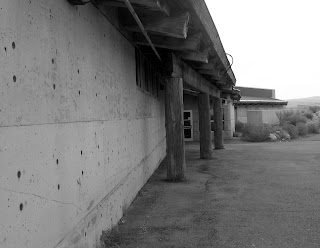 Heavy timber framing tied into concrete structure
Heavy timber framing tied into concrete structure
The center takes on the role of being one of transition and introduction to the lake and the island, rather than a point of destination. ‘After all, the island is the destination, not the building,’ McDonough explained.
To complete the feeling of being a part of the landscape on Ladyfinger Ridge, a sod roof planted with native grasses will delineate a portion of the extended building, while the remainder of the roof will be in keeping with the irregular jagged nature of the rock outcroppings surrounding the ridge.
The building’s form is linear in nature, respecting the topography. It is low to minimize the effect of prevailing storm winds from the northwest, and the silhouette is in accord with the terrain.
'It wouldn't do to have an obtrusive profile jutting up atop the ridge,' Cartwright said.
'This design is perfect for the subtle grade of its desert surroundings,' he added. 'It couldn't be put anywhere else.'
The entryway will offer exterior access to men's and women's restrooms; the interior exhibit area includes one large room and a central long room running the entire length of the facility.
A bookstore and gift shop will include an information desk at a central location to the store and the exhibit area.
A multiuse room will allow audio-visual presentations and lectures and an area for conference use with a view to the north. The center will be handicapped-accessible.
Some vending machines will be available, but there will be no food concession areas as such. There are picnic areas within close proximity of the center, and concessionaires on the beach nearby."
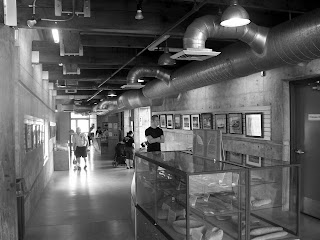 Interior showing the main linear axis of building
Interior showing the main linear axis of building

'Antelope visitors center designed to fit its setting'
Deseret News, Feb 8, 1995
"Architect Burke Cartwright said the center is being designed to fit the topography of its ridgeline site so it ‘looks like it has emerged from the site, belongs on the site, rather than being imposed on the site.’
Visitors will approach the center slightly uphill from parking lot, Cartwright explained, then enter and walk through a reception area and bookstore leading to the exhibits. Outside, hard surface paths will lead to observation points and outdoor exhibits.
The restrooms and outdoor exhibit areas will be accessible even when the center is closed, Cartwright said.
The exhibit areas will have carefully framed views of the island, Great Salt Lake, and back toward the mainland, he said.
 An example of a framed view the building provides, looking back at the causeway used to travel to the island.
An example of a framed view the building provides, looking back at the causeway used to travel to the island. Exterior framed view looking north
Exterior framed view looking northNative rock from the island will be used in some of the center construction, Cartwright said, but the walls will be built of poured concrete textured and tinted to blend in with the surroundings.
The native stone on the island can be used for some decorative work but is generally too porous for use as a primary construction material, he said.
Some site work has been done already and Cartwright said a three-dimensional model of the center could be prepared within a couple of weeks, and construction will start in the spring. He projects the center will be open by Memorial Day weekend of 1996."
 There is an amphitheater around the back side of the building
There is an amphitheater around the back side of the building Amphitheater
Amphitheater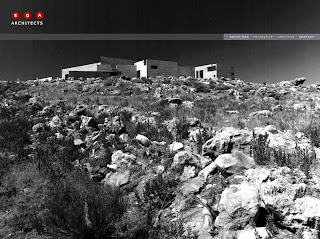 This image of the Visitors Center is currently part of the home page of EDA Architects
This image of the Visitors Center is currently part of the home page of EDA Architects  If you look closely, you can see the visitors center off in the distance in the upper left of this image. This gives a feel for how the building acts as an integral part of the landscape, rather than as an object in a field.
If you look closely, you can see the visitors center off in the distance in the upper left of this image. This gives a feel for how the building acts as an integral part of the landscape, rather than as an object in a field.



